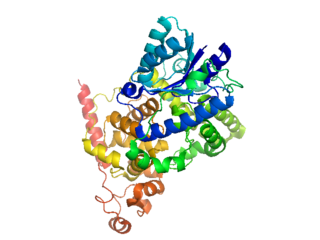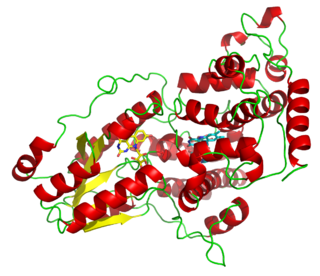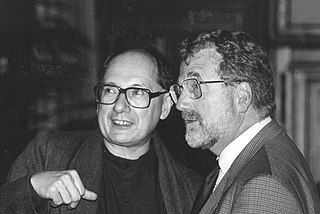
A chloroplast is a type of membrane-bound organelle known as a plastid that conducts photosynthesis mostly in plant and algal cells. The photosynthetic pigment chlorophyll captures the energy from sunlight, converts it, and stores it in the energy-storage molecules ATP and NADPH while freeing oxygen from water in the cells. The ATP and NADPH is then used to make organic molecules from carbon dioxide in a process known as the Calvin cycle. Chloroplasts carry out a number of other functions, including fatty acid synthesis, amino acid synthesis, and the immune response in plants. The number of chloroplasts per cell varies from one, in unicellular algae, up to 100 in plants like Arabidopsis and wheat.

Ribulose-1,5-bisphosphate carboxylase/oxygenase, commonly known by the abbreviations RuBisCo, rubisco, RuBPCase, or RuBPco, is an enzyme involved in light-independent part of photosynthesis, including the carbon fixation by which atmospheric carbon dioxide is converted by plants and other photosynthetic organisms to energy-rich molecules such as glucose. It emerged approximately four billion years ago in primordial metabolism prior to the presence of oxygen on Earth. It is probably the most abundant enzyme on Earth. In chemical terms, it catalyzes the carboxylation of ribulose-1,5-bisphosphate.
In developmental biology, photomorphogenesis is light-mediated development, where plant growth patterns respond to the light spectrum. This is a completely separate process from photosynthesis where light is used as a source of energy. Phytochromes, cryptochromes, and phototropins are photochromic sensory receptors that restrict the photomorphogenic effect of light to the UV-A, UV-B, blue, and red portions of the electromagnetic spectrum.
Photoperiodism is the physiological reaction of organisms to the length of light or a dark period. It occurs in plants and animals. Plant photoperiodism can also be defined as the developmental responses of plants to the relative lengths of light and dark periods. They are classified under three groups according to the photoperiods: short-day plants, long-day plants, and day-neutral plants.

Cryptochromes are a class of flavoproteins found in plants and animals that are sensitive to blue light. They are involved in the circadian rhythms and the sensing of magnetic fields in a number of species. The name cryptochrome was proposed as a portmanteau combining the chromatic nature of the photoreceptor, and the cryptogamic organisms on which many blue-light studies were carried out.
Phototropins are photoreceptor proteins that mediate phototropism responses in various species of algae, fungi and higher plants. Phototropins can be found throughout the leaves of a plant. Along with cryptochromes and phytochromes they allow plants to respond and alter their growth in response to the light environment. Phototropins may also be important for the opening of stomata and the movement of chloroplasts. These blue light receptors are seen across the entire green plant lineage. When Phototropins are hit with blue light, they induce a signal transduction pathway that alters the plant cells' functions in different ways.

Photolyases are DNA repair enzymes that repair damage caused by exposure to ultraviolet light. These enzymes require visible light both for their own activation and for the actual DNA repair. The DNA repair mechanism involving photolyases is called photoreactivation. They mainly convert pyrimidine dimers into a normal pair of pyrimidine bases. Photo reactivation, the first DNA repair mechanism to be discovered, was described initially by Albert Kelner in 1949 and independently by Renato Dulbecco also in 1949.

Marc, Baron Van Montagu is a Belgian molecular biologist. He was full professor and director of the Laboratory of Genetics at the faculty of Sciences at Ghent University (Belgium) and scientific director of the genetics department of the Flanders Interuniversity Institute for Biotechnology (VIB). Together with Jozef Schell he founded the biotech company Plant Genetic Systems Inc. (Belgium) in 1982, of which he was scientific director and member of the board of directors. Van Montagu was also involved in founding the biotech company CropDesign, of which he was a board member from 1998 to 2004. He is president of the Public Research and Regulation Initiative (PRRI).
Photoreceptor proteins are light-sensitive proteins involved in the sensing and response to light in a variety of organisms. Some examples are rhodopsin in the photoreceptor cells of the vertebrate retina, phytochrome in plants, and bacteriorhodopsin and bacteriophytochromes in some bacteria. They mediate light responses as varied as visual perception, phototropism and phototaxis, as well as responses to light-dark cycles such as circadian rhythm and other photoperiodisms including control of flowering times in plants and mating seasons in animals.
Period (per) is a gene located on the X chromosome of Drosophila melanogaster. Oscillations in levels of both per transcript and its corresponding protein PER have a period of approximately 24 hours and together play a central role in the molecular mechanism of the Drosophila biological clock driving circadian rhythms in eclosion and locomotor activity. Mutations in the per gene can shorten (perS), lengthen (perL), and even abolish (per0) the period of the circadian rhythm.
Reginald John Ellis is a British scientist.

In biology, phototropism is the growth of an organism in response to a light stimulus. Phototropism is most often observed in plants, but can also occur in other organisms such as fungi. The cells on the plant that are farthest from the light contain a hormone called auxin that reacts when phototropism occurs. This causes the plant to have elongated cells on the furthest side from the light. Phototropism is one of the many plant tropisms, or movements, which respond to external stimuli. Growth towards a light source is called positive phototropism, while growth away from light is called negative phototropism. Negative phototropism is not to be confused with skototropism, which is defined as the growth towards darkness, whereas negative phototropism can refer to either the growth away from a light source or towards the darkness. Most plant shoots exhibit positive phototropism, and rearrange their chloroplasts in the leaves to maximize photosynthetic energy and promote growth. Some vine shoot tips exhibit negative phototropism, which allows them to grow towards dark, solid objects and climb them. The combination of phototropism and gravitropism allow plants to grow in the correct direction.

Michael Morris Rosbash is an American geneticist and chronobiologist. Rosbash is a professor and researcher at Brandeis University and investigator at the Howard Hughes Medical Institute. Rosbash's research group cloned the Drosophila period gene in 1984 and proposed the Transcription Translation Negative Feedback Loop for circadian clocks in 1990. In 1998, they discovered the cycle gene, clock gene, and cryptochrome photoreceptor in Drosophila through the use of forward genetics, by first identifying the phenotype of a mutant and then determining the genetics behind the mutation. Rosbash was elected to the National Academy of Sciences in 2003. Along with Michael W. Young and Jeffrey C. Hall, he was awarded the 2017 Nobel Prize in Physiology or Medicine "for their discoveries of molecular mechanisms controlling the circadian rhythm".
A Light-oxygen-voltage-sensing domain is a protein sensor used by a large variety of higher plants, microalgae, fungi and bacteria to sense environmental conditions. In higher plants, they are used to control phototropism, chloroplast relocation, and stomatal opening, whereas in fungal organisms, they are used for adjusting the circadian temporal organization of the cells to the daily and seasonal periods. They are a subset of PAS domains.
Steve A. Kay is a British-born chronobiologist who mainly works in the United States. Dr. Kay has pioneered methods to monitor daily gene expression in real time and characterized circadian gene expression in plants, flies and mammals. In 2014, Steve Kay celebrated 25 years of successful chronobiology research at the Kaylab 25 Symposium, joined by over one hundred researchers with whom he had collaborated with or mentored. Dr. Kay, a member of the National Academy of Sciences, U.S.A., briefly served as president of The Scripps Research Institute. and is currently a professor at the University of Southern California. He also served on the Life Sciences jury for the Infosys Prize in 2011.

Drosophila circadian rhythm is a daily 24-hour cycle of rest and activity in the fruit flies of the genus Drosophila. The biological process was discovered and is best understood in the species Drosophila melanogaster. Other than normal sleep-wake activity, D. melanogaster has two unique daily behaviours, namely regular vibration during the process of hatching from the pupa, and during mating. Locomotor activity is maximum at dawn and dusk, while eclosion is at dawn.
Carla Beth Green is an American neurobiologist and chronobiologist. She is a professor in the Department of Neuroscience and a Distinguished Scholar in Neuroscience at the University of Texas Southwestern Medical Center. She is the former president of the Society for Research on Biological Rhythms (SRBR), as well as a satellite member of the International Institute for Integrative Sleep Medicine at the University of Tsukuba in Japan.
Carrie L. Partch is an American protein biochemist and circadian biologist. Partch is currently a Professor in the Department of Chemistry and Biochemistry at the University of California, Santa Cruz. She is noted for her work using biochemical and biophysical techniques to study the mechanisms of circadian rhythmicity across multiple organisms. Partch applies principles of chemistry and physics to further her research in the field of biological clocks.
Elaine Munsey Tobin is a professor of molecular, cell, and developmental biology at the University of California, Los Angeles (UCLA). Tobin is recognized as a Pioneer Member of the American Society of Plant Biologists (ASPB).
The chlorophyll a/b-binding protein gene, otherwise known as the CAB gene, is one of the most thoroughly characterized clock-regulated genes in plants. There are a variety of CAB proteins that are derived from this gene family. Studies on Arabidopsis plants have shed light on the mechanisms of biological clocks under the regulation of CAB genes. Dr. Steve Kay discovered that CAB was regulated by a circadian clock, which switched the gene on in the morning and off in the late afternoon. The genes code for proteins that associate with chlorophyll and xanthophylls. This association aids the absorption of sunlight, which transfers energy to photosystem II to drive photosynthetic electron transport.








